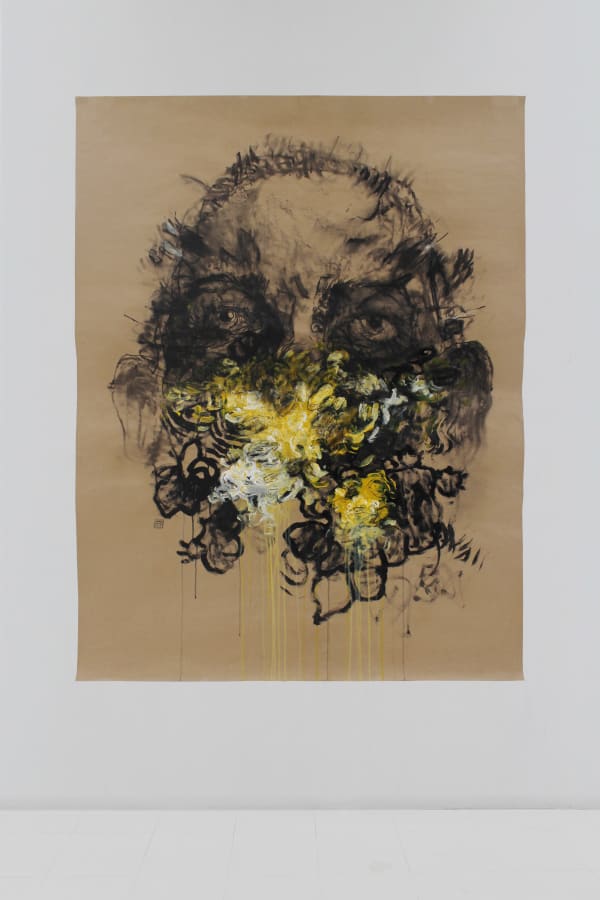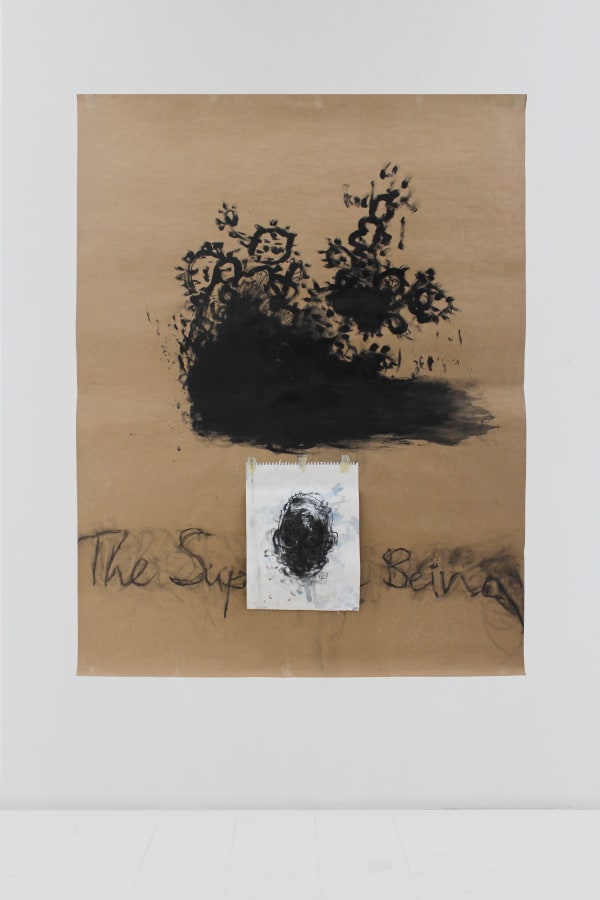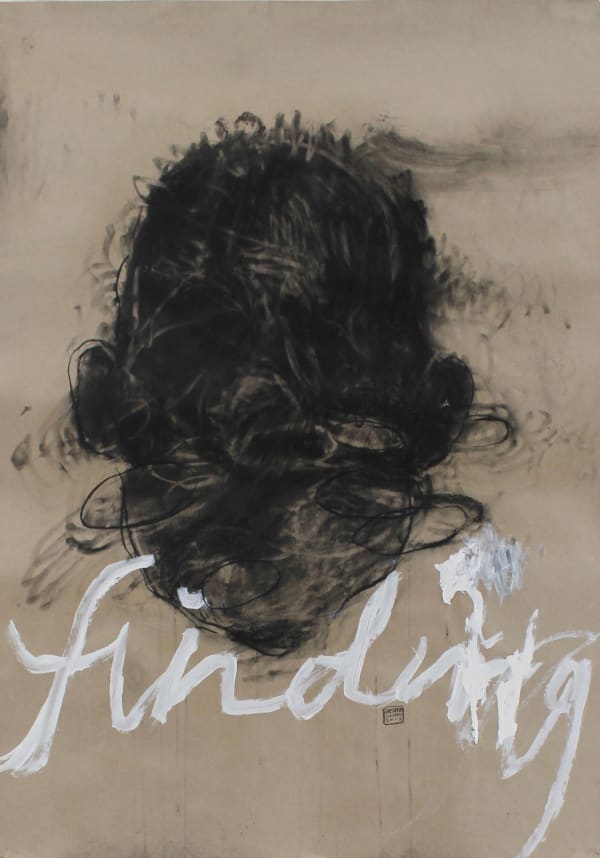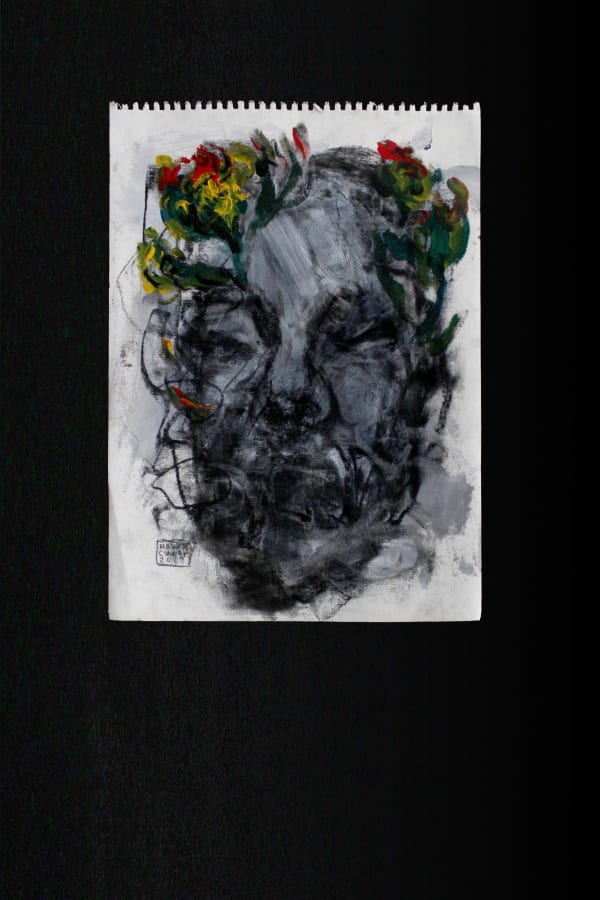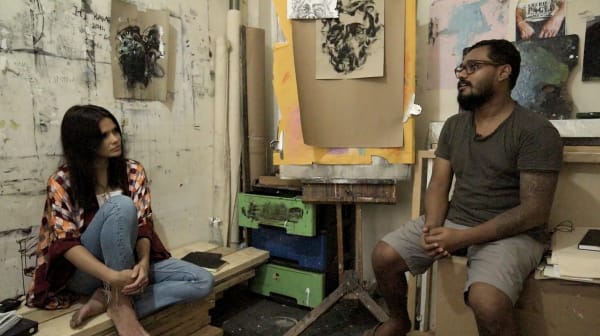DESIRE: HASHAN COORAY
The works, created over the past twelve months, feature drawings and painting across the themes of love, pain, desire and existentialism. The body of work is dominated by abstract self-por traits; an attempt at introspection. Incorporating words referring to God-like beings as well as lewd terminology, the images and writing aims to aggravate the senses leading to a further questioning of one's own conformity.
The mouthless face and other works are partly covered by his gestural paintings featuring the Cacti, a symbol of himself and the contradiction of the repelling nature of the plant combined with its nourishing interior. Instinctive, uid strokes are used to create many of the portraits resulting in a black form that resembles the face; to the artist these are his darkest, most questionable moments. The works are created using charcoal, paint and brushes that he constructs himself with ne coir and long sticks.
The three portraits represent the Holy Trinity, in continuity of the artists discussion and debate on the in uences on conformity. Using the depth of blackness in parallel with writing and colour; he plays with combinations of the aesthetic to under line his narrative. Hashan's portraits are not mirror images; they are representations of the soul.
-
 Hashan CoorayDesire 11, 2020Mixed Media on Paper & Canvas160 x 150 cm
Hashan CoorayDesire 11, 2020Mixed Media on Paper & Canvas160 x 150 cm
63 x 59 in -
 Hashan Cooray, Desire 12, 2020
Hashan Cooray, Desire 12, 2020 -
 Hashan Cooray, Desire 01, 2020
Hashan Cooray, Desire 01, 2020 -
 Hashan Cooray, Desire 06, 2020
Hashan Cooray, Desire 06, 2020
-
 Hashan Cooray, Desire 05, 2020
Hashan Cooray, Desire 05, 2020 -
 Hashan Cooray, Desire 03, 2020
Hashan Cooray, Desire 03, 2020 -
 Hashan Cooray, Desire 10, 2020
Hashan Cooray, Desire 10, 2020 -
 Hashan CoorayDesire 09, 2020Mixed Media on Paper160 x 122 cm
Hashan CoorayDesire 09, 2020Mixed Media on Paper160 x 122 cm
63 x 48 1/8 in
-
 Hashan Cooray, Desire 02, 2020
Hashan Cooray, Desire 02, 2020 -
 Hashan Cooray, Desire 04, 2020
Hashan Cooray, Desire 04, 2020 -
 Hashan CoorayDesire 08, 2020Mixed Media on Paper120 x 100 cm
Hashan CoorayDesire 08, 2020Mixed Media on Paper120 x 100 cm
47 1/4 x 39 3/8 in -
 Hashan CoorayDesire 17, 2019Mixed Media on Paper92 x 69 cm
Hashan CoorayDesire 17, 2019Mixed Media on Paper92 x 69 cm
36 1/4 x 27 1/8 in
Saskia Fernando Gallery is pleased to announce the new online exhibition by Hashan Cooray titled ‘Desire’. The works, created over the past twelve months, feature drawings and painting across the themes of love, pain, desire and existentialism. The body of work is dominated by abstract self-portraits; an attempt at introspection. Incorporating words referring to God-like beings as well as lewd terminology, the images and writing aims to aggravate the senses leading to a further questioning of one’s own conformity. The mouthless face and other works are partly covered by his gestural paintings featuring the Cacti, a symbol of himself and the contradiction of the repelling nature of the plant combined with its nourishing interior. Instinctive, fluid strokes are used to create many of the portraits resulting in a black form that resembles the face; to the artist these are his darkest, most questionable moments. The works are created using charcoal, paint and brushes that he constructs himself with fine coir and long sticks. The three portraits represent the Holy Trinity, in continuity of the artists discussion and debate on the influences on conformity. Using the depth of blackness in parallel with writing and colour; he plays with combinations of the aesthetic to underline his narrative. Hashan’s portraits are not mirror images; they are representations of the soul.
Hashan Cooray is a visual artist whose body of work engages his subjects beyond the stereotypical translation of portraiture. Gestural, intense and often dark subjects emerge from a raw canvas; notes scribbled in the back ground. Cooray is not a conventional painter, he began his work studying faces and people that he connected with as opposed to faces he admired. The result of this process is a body of work that engages his subject in an intrusive manner, exposing to the viewer all that lies beneath. Charcoal and acrylic on canvas combine to present an unfinished complete work that has the tactile nature of material present within it's composition. The brown paper charcoal paintings too possess this presence. Cooray's subjects engage, disturb and grab the viewer; they are not there to please.
Hashan Cooray was born in Colombo, Sri Lanka in 1987 and pursued a career as a visual artist via unconventional means of both self-learning, courses in fine art and his experience as an Art Director in the advertising industry. His works are predominantly portraiture that depict a deeper, more profound insight into his subjects. Averse to the 'pretty picture', Cooray's works are dark, intense and honest representations of the real world.
We find that Hashan’s intent to paint the beginning of a chapter in a world where humans are not driven by conscience, compassion or love leads him to use intricate detailing and chaotic brush strokes, representing the dawn of a whole new species. His works of art contain inscriptions quoting words of a poem to further explain the digitalised world and the evolution of society’s deliberate existence in cyberspace creating links unlike those that are built fundamentally on meaning and significance. - Azara Jaleel, ARTRA Magazine, 2019




